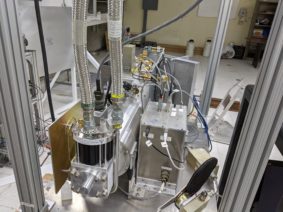
The Single-Pixel 1mm Receiver installed in the LMT instruments room.
The single-pixel 1mm receiver (or MSIP1mm) is a dual-polarization sideband-separation receiver that operates in the frequency range of 210 – 280 GHz. The receiver is primarily used for observations with the Event Horizon Telescope (EHT) array, but is also available for general astronomical use. The receiver uses superconducting junctions, and features ALMA Band-6 mixer-preamplifiers. Table 1 below lists the specifications of the receiver. The cryostat is cooled to 4 Kelvin, and has a square corrugated feed horn followed by an orthomode transducer (OMT) which splits the two polarizations into two separate mixer-preamplifiers. Each of these polarizations further separate the upper and lower sidebands of the intermediate frequency (IF) of 4 – 12 GHz (see Figure 1). In all four separate IF bands are available simultaneously and are fed into a spectrometer system. The orthogonal polarizations can be averaged together for each sideband. The receiver was designed and built at UMass, and provides characteristic receiver noise temperature of 60-75 K across the 210 – 280 GHz band. A flexible computer controlled local oscillator (LO) system allows tuning across the RF frequency range.

Figure 1: LO can be tuned between 220 to 270 GHz. At each LO setting the upper sideband (USB) and lower sideband (LSB) of the LO setting is separated out and sent to separate IF streams. Molecular lines in each sideband can therefore be separately observed.
The receiver was installed and commissioned in Spring 2018, and has been used for EHT runs and for spectral line observations. The receiver is connected to the same spectrometer system as SEQUOIA. The FPGA based spectrometer system has bandwidth options of 200, 400, and 800 MHz. The upper and lower sidebands of the receiver can be tracked to independent frequencies, so different spectral lines can be observed in each sideband.
Relevant information to be considered when requesting observing time with the MSIP1mm receiver can be found it the MSIP1mm Observing Summary. Sensitivity and integration time calculators for the 1mm receiver system are available in LMT-Hedwig, the LMT’s proposal submission system. Documentation and a simple example on how to use this calculators will soon be available.